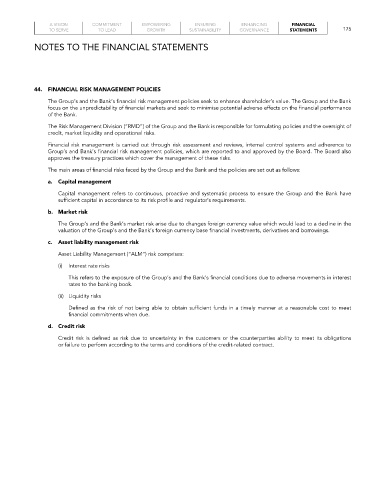Page 177 - EXIM-Bank_Annual-Report-2022
P. 177
A VISION COMMITMENT EMPOWERING ENSURING ENHANCING FINANCIAL
TO SERVE TO LEAD GROWTH SUSTAINABILITY GOVERNANCE STATEMENTS 175
Notes to the fiNaNcial statemeNts
44. FINaNCIaL RISk MaNaGEMENT POLICIES
The Group’s and the Bank’s financial risk management policies seek to enhance shareholder’s value. The Group and the Bank
focus on the unpredictability of financial markets and seek to minimise potential adverse effects on the financial performance
of the Bank.
The Risk Management Division (“RMD”) of the Group and the Bank is responsible for formulating policies and the oversight of
credit, market liquidity and operational risks.
Financial risk management is carried out through risk assessment and reviews, internal control systems and adherence to
Group’s and Bank’s financial risk management policies, which are reported to and approved by the Board. The Board also
approves the treasury practices which cover the management of these risks.
The main areas of financial risks faced by the Group and the Bank and the policies are set out as follows:
a. Capital management
Capital management refers to continuous, proactive and systematic process to ensure the Group and the Bank have
sufficient capital in accordance to its risk profile and regulator’s requirements.
b. Market risk
The Group’s and the Bank’s market risk arise due to changes foreign currency value which would lead to a decline in the
valuation of the Group’s and the Bank’s foreign currency base financial investments, derivatives and borrowings.
c. Asset liability management risk
Asset Liability Management (“ALM”) risk comprises:
(i) Interest rate risks
This refers to the exposure of the Group’s and the Bank’s financial conditions due to adverse movements in interest
rates to the banking book.
(ii) Liquidity risks
Defined as the risk of not being able to obtain sufficient funds in a timely manner at a reasonable cost to meet
financial commitments when due.
d. Credit risk
Credit risk is defined as risk due to uncertainty in the customers or the counterparties ability to meet its obligations
or failure to perform according to the terms and conditions of the credit-related contract.

